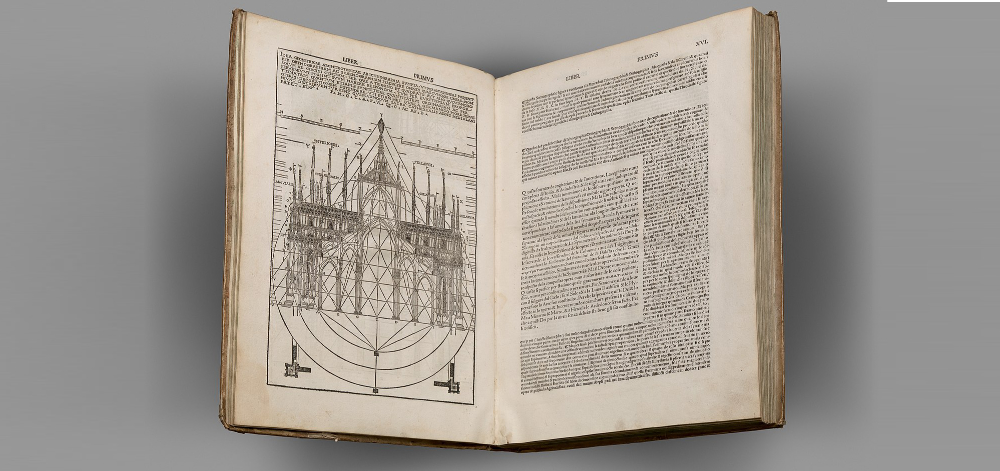Pattern book
The term 'pattern book' is normally used to refer to a book of samples or examples. It might be used in relation to fabric or wall paper selections, but also in design as a guide or set of instructions for certain objects with drawn examples.
An architectural pattern book, in particular might contain different example drawings of elements and distinctive features of types of building, or in urban planning, different street blocks and neighbourhood layouts..
One of the first set of what might be called architectural pattern books, was a series of Ten Books on Architecture, written and illustrated by the architect Vitruvius. Although some may refer to this as Illustrated architectural book or design code, it is in many ways a pattern book as it not only standardised the planning and construction of military camps and towns throughout the Roman Empire, but also codified the correct use of architectural orders for columns, entablatures and entranceways.
In doing this,Vitruvius provided a complete description of planning and building associated processes, in effect creating a framework for replication, practical instruction and dialogue that spanned centuries. Palladio too, as a follower of Vitruvius produced his Four Books of Architecture which might be considered a treatise and in a way a pattern book.
By the late 1700's many pattern books targetted potential client or noble landowners, containing illustrations of different types of housing designs. These books slowly developed and were not all tomes as Vitruvius had written but ranged from larger books to small booklets, designed as much for builders and carpenters as for clients. The books allowed users to share and popularise designs and to follow or recreate a given pattern outlined in them.
By the time the UK entered the Georgian era, and a period of mass development, pattern books had became important tools to both build with, but also as a form of marketing for the Georgian style,not only in the UK but also America, India, and Australia. By the 1800's in America many practical publications, builder’s companions and carpenter’s manuals were published such as Asher Benjamin’s American Builder’s Companion (1806); Owen Biddle’s The Young Carpenter’s Assistant (1805); and Minard Lafever’s The Modern Builder’s Guide (1833).
In 1881 two brothers by the name of Mitchell, embarked on an almost 30-year journey of writing, updating and modifying what became two separate construction books, the First Stage or Elementary and the expanded Advanced and Honours series, of the Mitchell’s construction books. Published initially by Batsford, and later Routledge they have become seminal books from this period giving both an understanding of design and construction for this period, but also showing the way to upgrade and or repair historic structures.
Pattern books and studies of buildings styles and methods continued to be recorded and shared throughout the 1900's. As digitisation grew and the availability of the first commercial Computer Aided Design (CAD) packages were a reality, digitalised pattern books of whole house designs for a variety of house types and styles were on offer. Today, off the shelf designs in 3 dimensional format can purchased by self builders along with more accessible tools to design bespoke schemes.
These to some extent owe a debt right back to the original pattern books that shared specialist knowledge and made it more readily available.
[edit] Related articles on Designing Buildings
Featured articles and news
The UK's Modern Industrial Strategy: A 10 year plan
Previous consultation criticism, current key elements and general support with some persisting reservations.
Building Safety Regulator reforms
New roles, new staff and a new fast track service pave the way for a single construction regulator.
Architectural Technologist CPDs and Communications
CIAT CPD… and how you can do it!
Cooling centres and cool spaces
Managing extreme heat in cities by directing the public to places for heat stress relief and water sources.
Winter gardens: A brief history and warm variations
Extending the season with glass in different forms and terms.
Restoring Great Yarmouth's Winter Gardens
Transforming one of the least sustainable constructions imaginable.
Construction Skills Mission Board launch sector drive
Newly formed government and industry collaboration set strategy for recruiting an additional 100,000 construction workers a year.
New Architects Code comes into effect in September 2025
ARB Architects Code of Conduct and Practice available with ongoing consultation regarding guidance.
Welsh Skills Body (Medr) launches ambitious plan
The new skills body brings together funding and regulation of tertiary education and research for the devolved nation.
Paul Gandy FCIOB announced as next CIOB President
Former Tilbury Douglas CEO takes helm.
UK Infrastructure: A 10 Year Strategy. In brief with reactions
With the National Infrastructure and Service Transformation Authority (NISTA).
Ebenezer Howard: inventor of the garden city. Book review.
The Grenfell Tower fire, eight years on
A time to pause and reflect as Dubai tower block fire reported just before anniversary.
Airtightness Topic Guide BSRIA TG 27/2025
Explaining the basics of airtightness, what it is, why it's important, when it's required and how it's carried out.
Construction contract awards hit lowest point of 2025
Plummeting for second consecutive month, intensifying concerns for housing and infrastructure goals.
Understanding Mental Health in the Built Environment 2025
Examining the state of mental health in construction, shedding light on levels of stress, anxiety and depression.























